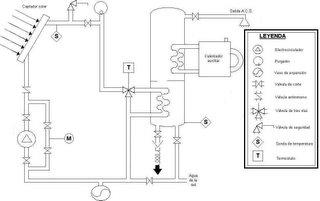Union collecting surface Calculation of Having calculated the energy consumption in each month is plotted on a curve or diagram of consumption.
The optimal angle depends on the use collectors that will perform the installation.
The calculation of the total surface collecting is done so that the solar contribution in the period in which the installation is active is equal to consumption. To get the number of collectors must match the annual consumption with solar contribution. The usable energy of an average day is obtained from horizontal irradiation in an average day of each month, H. This value is adjusted if the facility is located in a mountainous area or clean atmosphere (H * 1.05) or if area has a highly polluted air (H * 0.95). Other fixes the value H are done if there are obstacles that cast shadows on the collectors or reflective surfaces. E is thus:
E = k * H * 0'94
Also, if the orientation deviates x º South: E '= E * (1'14 -0 '0085 * x).
useful average intensity is equal to I = E (J) / T (sec)
Performance Calculation of a collector Each collector works with a performance given by a table or equations supplied by the manufacturer. Theoretical yield equation is b-m * (tm-ta º º) / I, where b is the incidence of the rays m the collector loses energy collector tm º average temperature of the battery, ta º temperature. b and m are constants and the rest is variable throughout the day and at different times. The manufacturers we can provide constant values.
Calculating the amount of energy received in a panel an estimate is made of energy to be received in a panel on the basis of geographic location, tilt the panel and the month in which it is calculated . This is only an estimate since it works with tables of place.
To perform this calculation is first query Estimated radiation table for the place in the month indicated and is multiplied by a correction factor depending on where you place the panel, a town with a lot of pollution, contaminated normal or low values \u200b\u200branging from 0.95, 1 or 1 ' 05 respectively. Then k is multiplied by another correction factor will depend on the inclination of the panel and latitude. If the value of the energy needed is divided by the energy from this calculation, the number of panels would be needed.
optimization calculation for the orientation and inclination of the panels First place should be fixed one of the two parameters, the orientation or inclination. After consulting on the graph is obtained from which values \u200b\u200bof guidance or inclination can vary our panel to achieve a desired performance. Can also be used, if you know these two parameters, to see if the losses are less than the maximum allowed. Once
know from which direction values \u200b\u200bmay be the panel that graduation should be corrected for the latitude of the place, with the formulas:
Maximum inclination: Tilt Max. - (41 ° - latitude)
Minimum slope: Tilt min. - (41 ° - latitude)
If you know the slope you will know from which grades may vary with the formula:
Orientation: Inclination - (41 ° - latitude)
Determination of the losses suffered by the shadows When the shadow occupies more than 5% of the panel, the yield would be much lower than expected. Under the law of Madrid, there can be no shadows at an altitude of 15 degrees on the elevation angle of the collectors. This calculation depends on the latitude and the Canaries would be 25 º.
To calculate losses using a shadow graph, which represents the path of the sun at all seasons, due to their different altitudes, moving the obstacle to this plot and the results are obtained by shadow loss.
Then the value of each cell is obtained from tables which vary depending on the orientation and inclination of the panel

